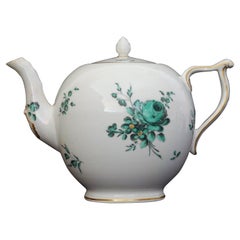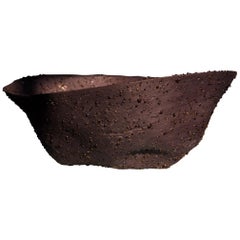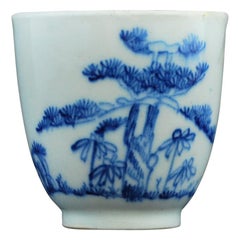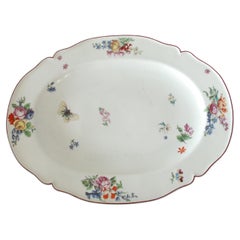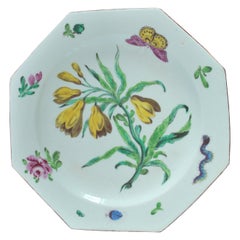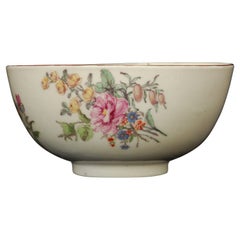Molded Porcelain
to
30
88
59
53
14
21
59
4
8
8
1
2
1
1
3
4
1
23
19
12
9
5
3
2
1
1
147
146
6
2
2
51
20
126
62
52
42
19
147
122
147
41
24
19
16
9
Technique: Molded
Teapot, Derby Porcelain Works, circa 1775
By Derby
Located in Melbourne, Victoria
A gadrooned, canon-ball shape teapot, decorated with typical sprays of natural flowers. The shape and decoration are both in imitation of Meissen.
The Derby Porcelain Works, now known as the Royal Crown Derby Porcelain Company, is a British manufacturer of fine bone china. The company has a long and rich history dating back to the late 18th century.
The company was founded in 1750 as the Derby China Works. It was originally located in the city of Derby and produced a wide range of ceramic wares, including tea sets, vases, and figurines. In 1756, the company was granted the status of "Supplier to the King," which allowed it to use the "Royal" designation in its name.
In the late 18th and early 19th centuries, the company experienced significant growth and expanded its product line to include more elaborate and ornate pieces. The company was particularly known for its "Derby Posies...
Category
Late 18th Century English Neoclassical Antique Molded Porcelain
Materials
Porcelain
$960 Sale Price
20% Off
Telluride, Black Big Bowl, Centrepiece, Porcelain, Dark, Modern, Vessel
By Tellurico
Located in Eindhoven, NL
The black big bowl is the dark variation of the Telluride Stracciatella, and it is a big bowl create in Volcanic Porcelain mixed with a dark black pigment. Th...
Category
2010s Dutch Modern Molded Porcelain
Materials
Porcelain
Coffee Cup, Bow Porcelain Factory, circa 1749
Located in Melbourne, Victoria
Of Chinese export form with loop handle; the body imaginatively painted in a bright ‘early blue’ underglaze with pine, rock and bamboo after the Chinese. Yellow tinged body; clear gl...
Category
Mid-18th Century English Rococo Antique Molded Porcelain
Materials
Porcelain
Large Dish or tureen stand, Chelsea, circa 1755
Located in Melbourne, Victoria
A fine tureen stand, typically painted with flowers and insects in the style of Meissen. A large and impressive piece.
Stilt marks and ground footrim.
Category
Mid-18th Century English Neoclassical Antique Molded Porcelain
Materials
Porcelain
Botanical Plate, Bow Porcelain Factory, circa 1755
Located in Melbourne, Victoria
A fine octagonal plate painted in the botanical style; possibly the yellow gloriosa climbing lily.
Provenance: Taylor Collection; Robyn Robb 2003.
Filled edge chips.
Category
Mid-18th Century English Neoclassical Antique Molded Porcelain
Materials
Porcelain
Waste Bowl, Chelsea, circa 1755
Located in Melbourne, Victoria
An unusual waste bowl (sometimes called a slop bowl) in soft-paste porcelain, decorated with typical Chelsea sprigs and bunches of flowers.
One of the most...
Category
Mid-18th Century English Neoclassical Antique Molded Porcelain
Materials
Porcelain
$1,840 Sale Price
20% Off
Contemporary Modern, Justine Porcelain Latte Cup with Handle, Pink
By DAY Studio
Located in İstanbul, İstanbul
Justine porcelain pieces are inspired by the ancient Byzantine jewelry. Delicate porcelain transforms cups into timeless design objects by tr...
Category
2010s Turkish Modern Molded Porcelain
Materials
Porcelain
Contemporary Modern, Justine Porcelain Latte Cup with handle, White & Blue
By DAY Studio
Located in İstanbul, İstanbul
Justine porcelain pieces are inspired by the ancient Byzantine jewelry. Delicate porcelain transforms cups into timeless design objects by tr...
Category
2010s Turkish Modern Molded Porcelain
Materials
Porcelain
Contemporary Modern, Justine Porcelain Coffee Cup & Saucer 100 ml, Beige & White
By DAY Studio
Located in İstanbul, İstanbul
Justine porcelain pieces are inspired by the ancient Byzantine jewelry. Delicate porcelain transforms cups into timeless design objects by translating pearl and stone details of jewe...
Category
2010s Turkish Modern Molded Porcelain
Materials
Porcelain
$68 Sale Price / set
20% Off
Contemporary Modern, Justine Porcelain Cappuccino Cup Without Handle, White&Blue
By DAY Studio
Located in İstanbul, İstanbul
Justine porcelain pieces are inspired by the ancient Byzantine jewelry. Delicate porcelain transforms cups into timeless design objects by translating pearl and stone details of jewe...
Category
2010s Turkish Modern Molded Porcelain
Materials
Porcelain
Contemporary Modern, Justine Porcelain Latte Cup with Handle, Navy
By DAY Studio
Located in İstanbul, İstanbul
Justine porcelain pieces are inspired by the ancient Byzantine jewelry. Delicate porcelain transforms cups into timeless design objects by tr...
Category
2010s Turkish Modern Molded Porcelain
Materials
Porcelain
Contemporary Modern, Justine Porcelain Cappuccino Cup with Handle, Pink
By DAY Studio
Located in İstanbul, İstanbul
Justine porcelain pieces are inspired by the ancient Byzantine jewelry. Delicate porcelain transforms cups into timeless design objects by tr...
Category
2010s Turkish Modern Molded Porcelain
Materials
Porcelain
Contemporary Modern, Justine Porcelain Cappuccino Cup with Handle, Beige & White
By DAY Studio
Located in İstanbul, İstanbul
Justine porcelain pieces are inspired by the ancient Byzantine jewelry. Delicate porcelain transforms cups into timeless design objects by tr...
Category
2010s Turkish Modern Molded Porcelain
Materials
Porcelain
Contemporary Modern, Justine Porcelain Latte Cup Without Handle, White & Blue
By DAY Studio
Located in İstanbul, İstanbul
Justine porcelain pieces are inspired by the ancient Byzantine jewelry. Delicate porcelain transforms cups into timeless design objects by tr...
Category
2010s Turkish Modern Molded Porcelain
Materials
Porcelain
Contemporary Modern, Justine Porcelain Latte Cup Without Handle, Beige & White
By DAY Studio
Located in İstanbul, İstanbul
Justine porcelain pieces are inspired by the ancient Byzantine jewelry. Delicate porcelain transforms cups into timeless design objects by tr...
Category
2010s Turkish Modern Molded Porcelain
Materials
Porcelain
Tea bowl and Saucer, Chelsea, circa 1752
Located in Melbourne, Victoria
From early in the red anchor period, a fluted tea bowl and saucer, exquisitely painted with flowers and insects.
Category
1750s English Neoclassical Antique Molded Porcelain
Materials
Porcelain
$3,920 Sale Price
20% Off
A Nun, perhaps a theatrical figure. England, probably Plymouth, circa 1750
By Plymouth Porcelain Factory 1
Located in Melbourne, Victoria
An interesting soft-paste porcelain figure of a Dominican Nun, perhaps the theatrical figure Heloise.
Although the Nun appears in various versions in European and English porcelain,...
Category
Late 18th Century English Neoclassical Antique Molded Porcelain
Materials
Porcelain
Seal in the Form of a Lion, Chelsea, circa 1755
Located in Melbourne, Victoria
A porcelain seal in for the form of a seated lion. With original gold mount, loop, and semi-precious stone: which has not been engraved.
Category
Mid-18th Century English Neoclassical Antique Molded Porcelain
Materials
Porcelain
Double-Handled Sauce Boat, Chantilly, circa 1770
Located in Melbourne, Victoria
A double-handled sauce boat, with simple cobalt decoration.
Category
Late 18th Century French Neoclassical Antique Molded Porcelain
Materials
Porcelain
$2,400 Sale Price
20% Off
Plate with Coiled Phoenix, Chelsea, C1754
Located in Melbourne, Victoria
A very fine plate, damasked with Gotzkowsky erhaben Blumen. Decorated after the Japanese with peonies and a coiled phoenix to the centre, using the Kakiemo...
Category
Mid-18th Century English Neoclassical Antique Molded Porcelain
Materials
Porcelain
$1,160 Sale Price
20% Off
Figure of a Nun, Perhaps Heloise, Bow Porcelain Factory, circa 1750
Located in Melbourne, Victoria
A classic example of early bow porcelain.
The figure is of a Dominican Nun, and is based on a continental model, probably Meissen.
Bow produced a number of apparently religious...
Category
Mid-18th Century English Neoclassical Antique Molded Porcelain
Materials
Porcelain
Spoon Tray, Decorated by James Hammett O'neale, Bow, circa 1760
Located in Melbourne, Victoria
From a Bow service with decoration attributed to the painter Jeffryes Hammett O'Neale, probably in the London workshop of James Giles. The tray with shallow rim and shaped outline wi...
Category
Mid-18th Century English Romantic Antique Molded Porcelain
Materials
Porcelain
Seal, I Still Hope, Derby Porcelain Works, circa 1760
By Derby
Located in Melbourne, Victoria
A delightul porcelain seal, depicting a young lady, seated on a mound. It is painted with the motto J'ESPRE ENCORE, or I Still Hope. No doubt this was intended as a gift, to be given...
Category
Late 18th Century English Neoclassical Antique Molded Porcelain
Materials
Porcelain
Soup Plate with Hans Sloane Type Painting, Chelsea, circa 1755
Located in Melbourne, Victoria
An octagonal soup-plate, decorated in the Hans Sloane style with morning glory, or convolvulus, to give its proper name.
Category
Mid-18th Century English Rococo Antique Molded Porcelain
Materials
Porcelain
$5,360 Sale Price
20% Off
Pair of Bread and Butter Plates Nantgarw Porcelain, circa 1815
By Moses Webster, Nantgarw Pottery
Located in Melbourne, Victoria
An exceptionally rare pair of bread and butter plates in Nantgarw’s superb soft-paste porcelain. Each piece is gilded and decorated in one of t...
Category
1810s Welsh Regency Antique Molded Porcelain
Materials
Porcelain
$2,000 Sale Price / set
20% Off
Winter, from the Four Seasons, Bow Porcelain Factory, circa 1750
Located in Melbourne, Victoria
A personification of Winter, from The Four Seasons.
Unusually fine condition for a figure of this period.
Category
Mid-18th Century English Neoclassical Antique Molded Porcelain
Materials
Porcelain
Knife and Fork, Kakiemon Decoration, Bow Porcelain Factory, circa 1749
Located in Melbourne, Victoria
An unsually early set of handles with original steel tines and blade. Pistol grip form moulded with acanthus scrolls, leaves and swags and painted with indianische Blumen in a Kakiem...
Category
Mid-18th Century English Japonisme Antique Molded Porcelain
Materials
Porcelain
